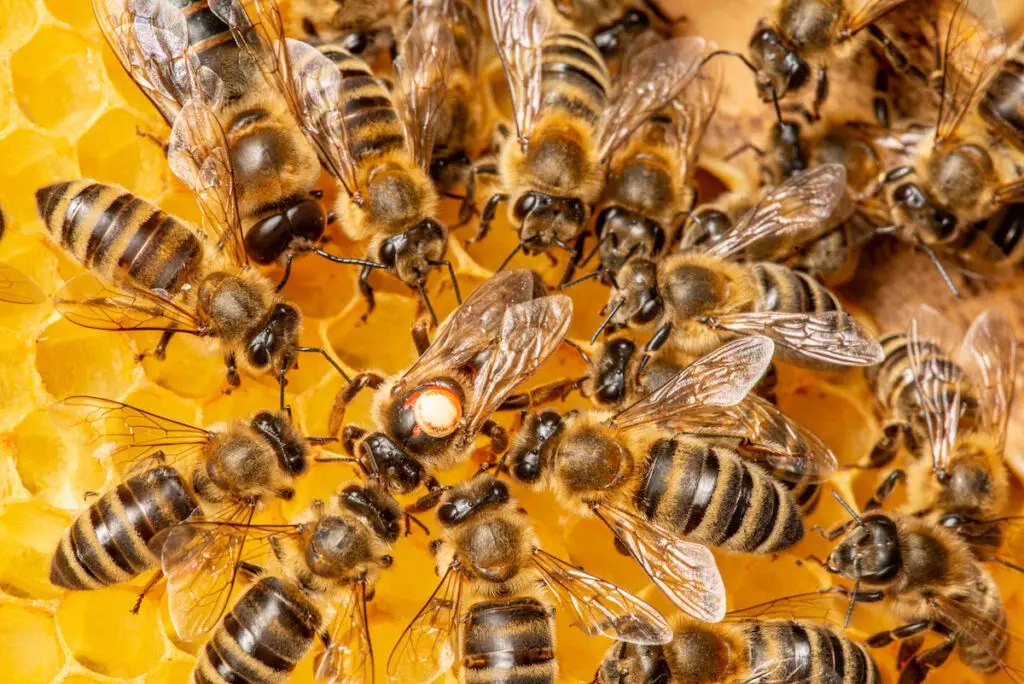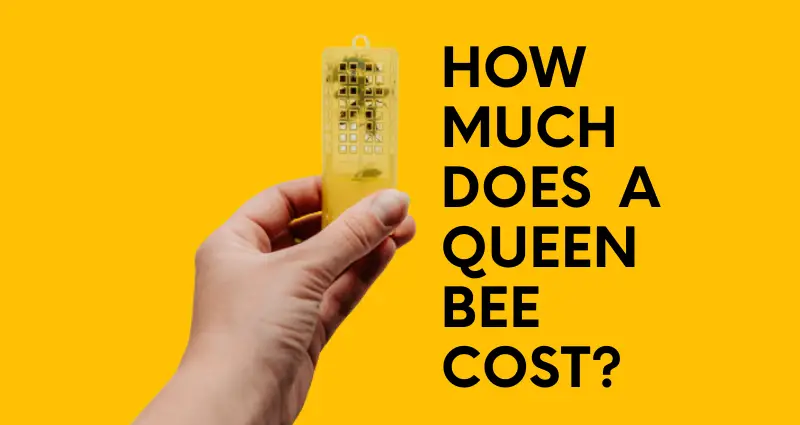New queen bees cost between $25-$40. However, some queens with desirable breeding characteristics may command $70-$200 or more. Replacing an older or sick queen is a worthwhile expense for hive productivity.
As experienced beekeepers know, the success of a beehive depends on a fertile queen bee who lays the eggs that will become workers, drones, and even future queens.
To ensure the colony will prosper, the keeper might have to periodically buy new queens to replace older, less fertile monarchs. How much can a hive owner expect to pay for a new queen?
The cost of a new queen ranges from $20-$100+, with the average price being in the $25-$40 range. Queen bees in the $70-100 range have certain breeding characteristics a hobbyist or professional beekeeper might be willing to pay more for.
All costs are plus shipping, which can be almost as much as the Royal Highness herself.
Click here to learn how to find the queen bee in a hive.

What Determines The Worth Of A Honey Bee Queen?
The worth of a honey bee queen depends on four variables,
Age. A queen may live up to 7 years. She will fly to a “drone congregation area” where she will mate with 12-15 drones and collect as many as 6 million sperm to store in her body. Over her life span, she will periodically release sperm to fertilize eggs that become worker bees and queens. Any of the millions of eggs she lays that are not fertilized become drones. In her most productive years, she lays 1,500 eggs per day, 200,000 per year, and over 1 million in her lifetime.
Queens are purchased color-coded to denote their age.
Health. After a few years, the queen’s productivity in laying eggs tapers off. During her most fertile years, she emits mandibular pheromones that influence social behavior, hive maintenance, swarming patterns, and mating behavior and inhibits ovary development in worker bees.
When this happens, the workers replace her in a procedure known as supersedure. When the queen’s pheromone emission is low, or she can no longer position herself in the brood cells to lay eggs, the worker bees assassinate the queen by clustering tightly around her and balling her to death as she overheats. A beekeeper might facilitate supersedure by clipping off the middle or posterior legs to upset her balance while laying eggs.
Breeding. Sometimes a beekeeper wants to introduce a queen bred for specific characteristics into the hive. It is impossible to know the genetics of the drones the queen mates with, but purchased queens might be more hygienic, which reduces the chance of varroa mite infestations, less aggressive, hardier during the winter, or known to produce more honey.
Purchased breeder queens tend to be the most expensive as they are injected with specific drone sperm.
Click here to learn more about the types of honey bees and their characteristics.
Species. Some species of bees have desirable traits as well. For example, Central American stingless bees are worth the extra cost to some hive keepers. Italian bees are reputedly gentler, more productive, and more disease-resistant as they are bred with VSH (Varroa Sensitive Hygiene.)
Why Buy A Queen Bee Rather Then Producing One In-Hive?
When a queen is waning in strength, she may die naturally or be killed by the process called queen balling. To prepare for a new queen, worker bees feed larvae in special queen cells with royal jelly.
Queens produced naturally in the hive are less likely to be rejected and are likely to live longer. However, the appeal of customizing hive production and behavior is worth it to many who turn to breeders when they need a queen.
Also, sometimes a colony of bees lacks the freshly fertilized eggs or very young larva to produce a queen. If the old queen dies, her death threatens the bee supply and future honey production. You may need to quickly intervene and buy a queen bee for a hive that needs one.
A hive left queenless for as little as 4-6 weeks can die off. So, time is of the essence!
NOTE: A healthy queen bee may live between 3 and 6 years.
Mated Queen Vs. Virgin Queen
A beekeeper can choose between two types of queens: a mated queen or a virgin queen.
A mated queen comes ready to lay eggs after having” open mated” with drones in the area. The drones may be from colonies known to have certain characteristics.
The alternative is a virgin queen who will fly out of her new home to “hook up“ with the local drones.
Buying a mated queen will lead to quicker hive growth as the new monarch will quickly begin egg-laying in the waxen cells of the hive.
Buying A Queen: Local Beekeepers Or Online Breeders
Buying bees and introducing them to your hive is not difficult.
Queen bees for readily available through the warm months of the year. Some local beekeepers might have a few extra queens on hand that they offer for sale.
Queens are also available online from bee farms that sell online and ship out queens and bee packages with next-day shipping. The queen will arrive at their new home in cell protectors to keep her warm or ventilated.
In either case, reserving the queen is crucial. If one is unavailable for immediate pickup or shipment, the seller will invoice the buyer and fill orders in the order they received payment.

Expanding Your Apiary With A Nuc or Bee Package
Someone who wants to form a new honey bee colony or grow the one they have may order a package of bees or a nuc (nucleus colony) that contains frames such as brood boxes and supers for honey storage.
Both packages and nucs may include queen. In a nuc, the bees and the queen honey bee herself are related, so all bees have the same inbreed characteristics.
With a package, the bees and queen are not related, so the new colony or those bees introduced into an existing one are of random heritage.

